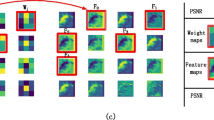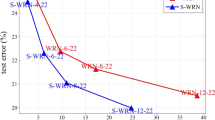Abstract
Currently, in order to deploy the convolutional neural networks (CNNs) on the mobile devices and address the over-fitting problem caused by the less abundant datasets, reducing the redundancy of parameters is the main target to construct the mobile CNNs. Based on this target, this paper proposes two novel convolutional kernels, multiple group reused convolutions (MGRCs) and decomposed point-wise convolutions (DPCs), to improve the efficiency of parameters by removing the parameter’s redundancy. The summation of MGRC and DPC is called high-parameter-efficiency convolutions (HPEC) in this paper, and the relevant CNNs can be called HPE-CNNs. Experimental results showed that, compared with the traditional convolutional kernels, HPEC can greatly decrease the model size without affecting the performance. Additionally, since the HPE-CNNs reduce the redundancy of parameters more thoroughly than the other mobile CNNs, they can address the over-fitting problem more effectively on the challenging datasets with less abundant training information.







Similar content being viewed by others
References
Chollet F (2016) Xception: deep learning with depthwise separable convolutions. CoRR arXiv:abs/1610.02357
Darlow LN, Crowley EJ, Antoniou A, Storkey AJ (2018) CINIC-10 is not ImageNet or CIFAR-10. CoRR arXiv:abs/1810.03505
De Lathauwer L (2008) Decompositions of a higher-order tensor in block terms part II: definitions and uniqueness. SIAM J Matrix Anal Appl 30(3):1033–1066
Deng J, Dong W, Socher R, Li LJ, Li K, Fei-Fei L (2009) Imagenet: a large-scale hierarchical image database. In: IEEE conference on computer vision and pattern recognition, 2009 (CVPR 2009). IEEE, pp 248–255
Gastaldi X (2017) Shake-shake regularization. CoRR arXiv:abs/1705.07485
He K, Zhang X, Ren S, Sun J (2016) Deep residual learning for image recognition. In: The IEEE conference on computer vision and pattern recognition (CVPR), pp 770–778
He Y, Zhang X, Sun J (2017) Channel pruning for accelerating very deep neural networks. In: 2017 IEEE international conference on computer vision (ICCV), pp 1398–1406. https://doi.org/10.1109/ICCV.2017.155
Howard AG, Zhu M, Chen B, Kalenichenko D, Wang W, Weyand T, Andreetto M, Adam H (2017) Mobilenets: efficient convolutional neural networks for mobile vision applications. CoRR arXiv:abs/1704.04861
Hu Y, Sun S, Li J, Wang X, Gu Q (2018) A novel channel pruning method for deep neural network compression. CoRR arXiv:abs/1805.11394
Huang G, Li Y, Pleiss G, Liu Z, Hopcroft JE, Weinberger KQ (2017) Snapshot ensembles: Train 1, get M for free. CoRR arXiv:abs/1704.00109
Huang G, Liu S, van der Maaten L, Weinberger KQ (2017) Condensenet: an efficient densenet using learned group convolutions. CoRR arXiv:abs/1711.09224
Huang G, Liu Z, Maaten LVD, Weinberger KQ (2017) Densely connected convolutional networks. In: IEEE conference on computer vision and pattern recognition, pp 2261–2269
Huang G, Sun Y, Liu Z, Sedra D, Weinberger K (2016) Deep networks with stochastic depth. In: European conference on computer vision. Springer, New York, pp 646–661
Krizhevsky A, Hinton G (2009) Learning multiple layers of features from tiny images. Tech. rep, Citeseer
Krizhevsky A, Sutskever I, Hinton GE (2012) Imagenet classification with deep convolutional neural networks. Adv Neural Inf Process Syst 25(2):2012
Larsson G, Maire M, Shakhnarovich G (2016) Fractalnet: ultra-deep neural networks without residuals. CoRR arXiv:abs/1605.07648
Lu Y, Lu G, Zhang B, Xu Y, Li J (2019) Super sparse convolutional neural networks. In: Proceedings of the thirty-third AAAI conference on artificial intelligence, vol 33, 4440–4447. https://doi.org/10.1609/aaai.v33i01.33014440. https://aaai.org/ojs/index.php/AAAI/article/view/4356
Luo JH, Wu J, Lin W (2017) Thinet: a filter level pruning method for deep neural network compression. In: 2017 IEEE international conference on computer vision (ICCV), pp 5068–5076. https://doi.org/10.1109/ICCV.2017.541
Ma N, Zhang X, Zheng H, Sun J (2018) Shufflenet V2: practical guidelines for efficient CNN architecture design. CoRR arXiv:abs/1807.11164
Patryk C, Ilya L, Frank H (2017) A downsampled variant of imagenet as an alternative to the CIFAR datasets. CoRR arXiv:abs/1707.08819
Romero A, Ballas N, Kahou SE, Chassang A, Gatta C, Bengio Y (2014) Fitnets: hints for thin deep nets. CoRR arXiv:abs/1412.6550
Sandler M, Howard AG, Zhu M, Zhmoginov A, Chen L (2018) Inverted residuals and linear bottlenecks: Mobile networks for classification, detection and segmentation. CoRR arXiv:abs/1801.04381
Singh S, Hoiem D, Forsyth D (2016) Swapout: learning an ensemble of deep architectures. In: Advances in neural information processing systems, pp 28–36
Sun K, Li M, Liu D, Wang J (2018) Igcv3: interleaved low-rank group convolutions for efficient deep neural networks. CoRR arXiv:abs/1806.00178
Sutskever I, Martens J, Dahl G, Hinton G (2013) On the importance of initialization and momentum in deep learning. In: International conference on machine learning, pp 1139–1147
Wang J, Wei Z, Zhang T, Zeng W (2016) Deeply-fused nets. CoRR arXiv:abs/1605.07716
Xie G, Wang J, Zhang T, Lai J, Hong R, Qi G (2018) Interleaved structured sparse convolutional neural networks. In: 2018 IEEE/CVF conference on computer vision and pattern recognition, pp 8847–8856. https://doi.org/10.1109/CVPR.2018.00922
Xie S, Girshick R, Dollar P, Tu Z, He K (2017) Aggregated residual transformations for deep neural networks. In: 2017 IEEE conference on computer vision and pattern recognition (CVPR), vol 00, pp 5987–5995. https://doi.org/10.1109/CVPR.2017.634
Zagoruyko S, Komodakis N (2016) Wide residual networks. In: Richard ERH, Wilson C, Smith WAP (eds) Proceedings of the British machine vision conference (BMVC). BMVA Press, pp 87.1–87.12. https://doi.org/10.5244/C.30.87
Zhang T, Qi G, Xiao B, Wang J (2017) Interleaved group convolutions. In: 2017 IEEE international conference on computer vision (ICCV), pp 4383–4392. https://doi.org/10.1109/ICCV.2017.469
Zhang X, Zhou X, Lin M, Sun J (2018) Shufflenet: An extremely efficient convolutional neural network for mobile devices. In: 2018 IEEE/CVF conference on computer vision and pattern recognition, pp 6848–6856. https://doi.org/10.1109/CVPR.2018.00716
Zhao L, Wang J, Li X, Tu Z, Zeng W (2016) On the connection of deep fusion to ensembling. CoRR arXiv:abs/1611.07718
Acknowledgements
This work is supported by NSFC Fund (61332011, 61906162), Shenzhen Fundamental Research Fund (JCYJ20170811155442454, JCVJ20180306172023949), Shenzhen Medical Biometrics Perception and Analysis Engineering Laboratory, Postdoctoral Science Foundation (2019TQ0316), Shenzhen Research Institute of Big Data, Shenzhen Institute of Artificial Intelligence and Robotics for Society, and Shenzhen Fundamental Research Fund from Shenzhen Science, Technology and Innovation Commission.
Author information
Authors and Affiliations
Corresponding author
Ethics declarations
Conflict of interest
The authors declare that they have no conflict of interest.
Additional information
Publisher's Note
Springer Nature remains neutral with regard to jurisdictional claims in published maps and institutional affiliations.
Rights and permissions
About this article
Cite this article
Lu, Y., Lu, G., Li, J. et al. High-parameter-efficiency convolutional neural networks. Neural Comput & Applic 32, 10633–10644 (2020). https://doi.org/10.1007/s00521-019-04596-w
Received:
Accepted:
Published:
Issue Date:
DOI: https://doi.org/10.1007/s00521-019-04596-w




